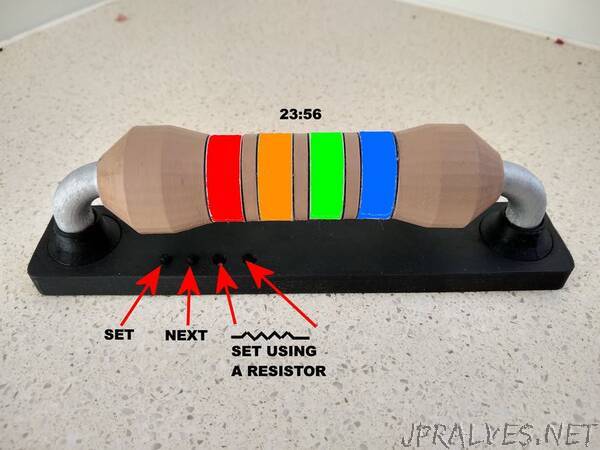
“A clock that shows the time using the resistor color code. With a built-in auto-ranging ohm meter, you can set the time with a resistor.
This clock is shaped like a big resistor and shows the time by lighting up the bands with the equivalent resistor color code.
Setting the time
The clock supports setting the time using a pair of buttons or by reading the value of an actual resistor placed on its two terminals.
The two buttons are SET and NEXT. Pressing the SET button will cause the Hours - Ten and Hours - Units bands to flash. The NEXT button will advance the hours. It will automatically roll around to zero (BLACK - BLACK) after reaching 23 (RED - ORANGE). Pressing the SET button will fix the hours and flash the Minutes - Ten band. The NEXT button will advance the tens of minutes. It will automatically roll around to zero (BLACK) after reaching 5 (GREEN). Pressing the SET button will fix the tens of minutes and flash the Minutes - Units band. The NEXT button will advance the units of minutes. It will automatically roll around to zero (BLACK) after reaching 9 (WHITE). Pressing the SET button again will write the time back to the Real Time Clock (RTC).
To set the time using a resistor, place the resistor on the terminals and press the NEXT button. Values greater than 100,000 ohms are ignored. Any value greater than 2359 ohms will cause the clock to be set to 23:59. Any minute value greater than 59 will cause the clock to be set to 59 minutes. A 390 ohms resistor for example will cause the time to display 03:59.
Circuit design
The clock is built around a ATtiny1614 microprocessor. It uses a DS1307 RTC (Real Time Clock) to keep the time even when the clock is not powered. Two tactile buttons are used to manually set the time. The clock also includes a auto-ranging ohm meter so that you can set the time using a resistor. eg a 1000 ohm resistor will set the time to 10:00am where as a 2200 ohm resistor will set the time to 2200 hours or 10:00pm.
The ohm meter uses a analog pin to read the output of a voltage divider using a known resistor and the resistor being measured. It has five ranges and each range is switched by a P-Channel MOSFET.”
